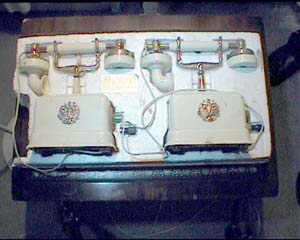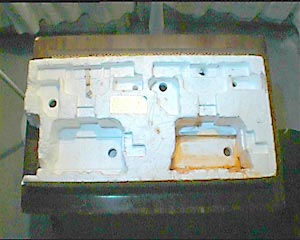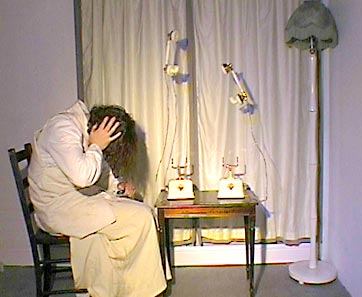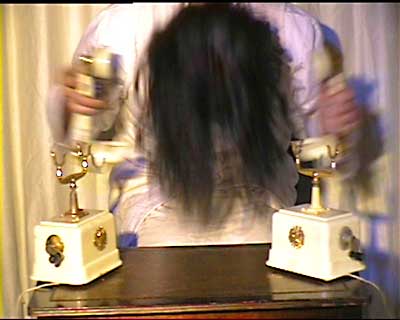
Caroline BergvallBODY & SIGNSome thoughts around the work of
|
|
This article provides a sketch of thoughts regarding poetic practices rooted in corporeal experiments. I’ve chosen three writers for whom bodywork is a central motif and who share an interest in the altered states of consciousness promoted by various kinds of bodily discipline: — In Hearing Things, the British performance poet Aaron Williamson confines his body in a room to create performances transformed into text by various technological media. — In The Fast, the American poet Hannah Weiner provides a detailed summary of a prolonged period of fasting.
— In Miserable Miracle, the French poet Henri Michaux revisits the texts and drawings laid down during his experiments with the drug mescaline. |
|
The importance of transcription and notational technique is paramount in work of this kind. The question of compositional control and authorial unity is stretched or pre-occupied with this. It is to do with chance-generation of text out of physical action (Williamson), with the trance-like productions of drawings and writings in the case of Michaux, or with the compulsion to see, later to see as a compulsion to write (Weiner). The writing’s starting-point is not primarily in language nor in textuality. The transmission of physical experience carries modes of writing which are not solely reliant on structures dictated by poetic construction. Perhaps not surprisingly, motifs of circuitry and electricity abound in all three projects. Notions of current transmitted or energy captured function both as the leitmotifs of the experiences undergone, and as the way writing is taking place. From somatic response, or impulse, to textual trace, writing is transmitted, prior to being written. Transmission indicates a relay, carriage, waves, material carried from one form to another, one place to another. A chain of emission.
1
To observe one’s body is to lay siege to it. Even for a limited period of time, devising specific rules to regulate one’s behaviour, demands great effort of concentration as well as a capacity for physical exertion of a kind which can threaten, or indeed collapse, a sense of personal safety. Especially if one has laid no or few provisions. Kenneth Goldsmith’s Applet project Fidget is certainly one such example. The 12-hr project of detailing all of his body movements by dictaphone, and transcribing it without edit, is documented as having ended in a drunken panic. In bookform, every word of the last two pages has been printed backwards. Thankfully this is not mirror-writing, but a quick fix, an illustrative kind of textual spit. The writer’s body finds itself dismantled, brutalised, shook up, helpless, useless puppet, prey to disorganised ideas. Yet to place one’s body at the centre of writing’s work indicates a methodical and pragmatic interest in forms of awareness which are not primarily, or solely, linguistic, nor it follows, poetic. In this begins the thrill, and the threat. |
|
It can also be connected to the critical and transitory practices of perfomance art as they have addressed embodiment and language in recent Western arts practice. Artists interested in performance for its politically confrontational and intimately transformative value have picked up on the binarism as a model for a dynamic reinvestment of the-body in art. Carolee Schneeman’s ‘Interior Scroll’ is perhaps one of its early significative moments, where body and writing are made to function as non-metaphoric extension of one another. Aaron Williamson has claimed Artaud and the performance artist Marina Abramovic as influences on his performances and poetic work. Both have produced work at the breaking points of their own socialised, verbalised bodies. Artaud irremediably fractured by the ritual wiring up of clinical treatments, his textual work moves increasingly closer to Momo’s onomatopoeic vociferations. Abramovic exposes herself to long, arduous physical tasks, often involving various ascetic disciplines, sometimes with invited participants. Her work is documented through photographic monographs (of which Cleaning the House is the most recognised), performance rumours, and the ritualised objects she places in galleries for the audience to use / be taken up by. |
| |

|
| |

|
| |
 |
|
‘Two phones’, ‘One phone’, and ‘No phones’, from the ‘Telemancy’ section of Hearing Things (2001) by Aaron Williamson, copyright © Aaron Williamson, courtesy the artist and BookWorks, London.
And augury is a means of accessing the-future, the non-time of alterity. It does not belong to a worldview which considers the centrality of human nature. It conjures up the interdependence of animate things, as much as the dormant power of inanimate things. Importantly, it relies first and foremost on an unbroken contact between all kinds of signs. Neither the poet nor the text run the show on their own. They cannot be subsumed solely to the regulating frames of the poetic, nor obey calls about the autonomous function of its production. Williamson’s technological augury aims to signal a process in which there is perceived correspondence between things and language, the book of Nature (the-body) teeming with signs: gestures (Derrida’s ‘action-language’), object manipulation, verbal discourse. Poetic work that subsumes itself to this might lessen the gap. Between human and non-human. Between body and writing. Between matter and light. ‘The bigger picture is the one in which your back-lit fingers turn to birds and a slow, wet blink is watered with augurs’ (Chiromancy, 54). |
| |

|
|
‘Phones in Air’, from the ‘Telemancy’ section of Hearing Things (2001) by Aaron Williamson, copyright © Aaron Williamson, courtesy the artist and BookWorks, London.
A combination of portrait sized and close-up details function as visual excerpts. They create a visual indexing or photographic notation: telephone, feather, balloon, milk, arrow, cards, scroll, table, toes, mask, sheet, wax-ear, hand-claps... motivated objects which are a little like these ‘phasms’ identified by Georges Didi-Huberman: symptoms of objects as much as symptoms of sight, objects in state of appearing, or rather of shifting from photographic image to visual surface, one brings on the other, both unsettled. Deformed. Probing his writer’s body, it is in experiencing its immateriality, as much as its materiality, that Williamson seeks to square with. Interjections of the physical realm. Must one rethink the boundaries between the seen and the unseen, document the unbelieved, the unperceived, in order to extend the realm of what is perceivable? Vocabularies, techniques, need to account for the magnitude of perceptual (and it follows, intellectual) changes implied. ‘When you shiver, the signal finds it harder to pick you up. To pick you out among rivulets’ (Belomancy, 26). |
| |

|
|
‘Shaking the Phones’, from the ‘Telemancy’ section of Hearing Things (2001) by Aaron Williamson, copyright © Aaron Williamson, courtesy the artist and BookWorks, London.
Williamson’s body doubles up as a tool for generating verbal writing. The computer reads/writes the sonic emissions of his choreographed body and spatial object manipulations. He scratches, jumps on, pulls at, screams into, gets picked up by the speech-recognition device. The written transcripts of text generated through the computer software (its pool of 250,000 stored words) appear without punctuation and as one continuous line running throughout the book, in a repetitive, largely alliterative sentence of non-syntactical juxtapositions which reinforces the spatial and temporal traffic of discontinuities and irregularities involved in performing these gesturals. ‘about the abandoned into the condemned to a bit of the up at a the tea and didn’t clue in the condemned a bit abandoned or a puppet of abandon in a type of the wool lean line will and he unearthed in the bone panel to only...’. A note in the margin of each such ‘found text’ specifies the augury explored. Here, ‘text generated by striking marks on paper’. |
2
Writing which has emerged from the writer’s prolonged dips into extremes of physical experience or experiences of voluntary confinement, might also attempt to relay textually, visually, the knowledge stored and revealed by these prolonged contacts with non-verbal phenomena. Corporeal events that make it into a verbal text have a way of measuring the immensity that has cut into the subjective, and most likely stylistic, space of the author. Writing which involves describing such a training, or breaking down, of the physical, mental body is partly dependent on elements outside of the writing. These in turn dictate aspects of the textual structure. To endeavour to transmit such events is an attempt at manifesting the intimate proximity of what remains most unknown, most changeable and precarious, the workings of one’s own body. |
3
After his experiences with mescaline, which became the texts and drawings compiled in Miserable Miracle (2002/ Fr.1972), Henri Michaux specifies in his foreword: ‘From the thirty-two autograph pages reproduced out of the hundred and fifty written while the inner perturbation was at its height, those who can read handwriting will learn more than from any description. As for the drawings, begun immediately after the third experiment, they were done with a vibratory motion that continues in you for days and days and, though automatic and blind, reproduces exactly the visions to which you have been subjected, passes through them again’. The book is made of a selection of these drawings, hand-written pages, textual pages. The whole experiment carefully framed, ‘this book is an exploration’. The writing has taken place after the event (‘everything had to be rewritten’) and is meticulously descriptive, critical, self-conscious. Paragraphs are full of questions as to what is ‘seen’, hesitations as to what to make of it. Its rhythm is repetitive, at times breathless, crowded, this reinforced by the short sequences which run in the margins, juxtapositions that ‘suggest very inadequately the overlappings which are an ever-present phenomenon of Mescaline’ (6). Footnotes remind us that this text, the drawings, the whole experience is under observation, is collecting up the findings of a project of research. |
¶
Of prime concern here has been to sketch out the way three contemporary poets have created work which exemplifies a number of connections between writerly and corporeal inscriptions. For Weiner and Michaux, as much as for Williamson, textual innovation is attached to the necessity of experiment as the necessity of experience, not to a sacrificial logic. Writing is made to answer to or extend the impulses of the writer’s body into fields of corporeal knowledge. As Shusterman in his collection of essays Performing Live, writes: ‘Recognition of the problematic mediacy of body representation has led body-centered thinkers to locate the body’s foundation and immediacy not in its external form but in its lived experience, its kinaesthetic sense of itself’ (Shusterman, 149). |
BibliographyKenneth Goldsmith, Fidget (CoachHouseBooks, 2000). Elizabeth Grosz, Volatile Bodies: Towards a Corporeal Feminism (Indiana University Press, 1994). Michel Foucault, The Order of Things (Routledge, 1989 / Gallimard, 1966). Susan Hiller (Tate Gallery Liverpool, 1996). Henri Michaux, Miserable Miracle tr. by Louise Varèse/ Anna Moschovakis (New York Review Books, 2002 / NRF, 1972). Henri Michaux, Face à ce qui se dérobe (NRF, 1975). Avital Ronell, The Telephone Book: Technology, Schizophrenia, Electric Speech (Nebraska University Press, 1989). Richard Shussterman: Performing Live: Aesthetic alternatives for the ends of art (Cornell University Press, 2000). Daniel Tiffany, Toy Medium: Materialism and Modern Lyric (California University Press, 2000). Hannah Weiner, The Fast (United Artists, 1992). Hannah Weiner, silent teachers remembered sequel (Tender Buttons #6, 1993).
Aaron Williamson, Hearing Things (BookWorks, 2001). |
|
Jacket 22 — May 2003
Contents page This material is copyright © Caroline Bergvall
and Jacket magazine 2003 |